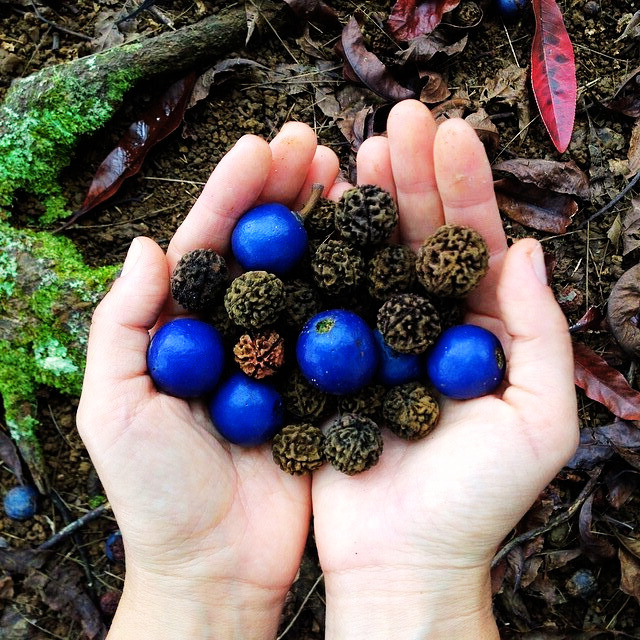This article was inspired by the discovery of Indonesian rudraksha malas sold in Kashi, a place steeped in Hindu spiritual history. Rudraksha is found in specific parts of the world. At the Pashupatinath Temple, priests give out big, beautiful, vibrant beads as prasadam. Shops sell authentic beads, and even boat vendors sell decent quality rudraksha malas during excursions on the Ma Ganga in Kashi. I was looking for beads to gift to those specifically requesting Nepali-sourced beads. In the process, I learned much more about the spiritual legacies and history of the beads, their cultivation, and their authenticity. While Himalayan rudraksha can be abundant in Nepal, many sacred sites in India offer rudraksha from Indonesia. The spiritual value of wearing these beads is an educational exploration.
The word “rudraksha” literally means “the tears of Rudra,” another name for Bhagwan Shiva, Adiyogi, the first Yogi. Legend has it that Bhagwan Shiva shed tears of ecstasy during deep states of meditation, which sprouted into rudraksha trees when they touched the ground. The benefits of wearing rudraksha beads are profound, as they enhance calmness and make one more focused. These seeds have unique vibrations, unlike any other substance. They are worn by people on spiritual paths because they cleanse and purify the aura. The beads are also conducive for those on the move, finding themselves in diverse environments and situations.
Rudraksha is the seed of the Elaeocarpus ganitrus tree, which thrives in specific altitudes in the Himalayan region. However, India’s population has significantly declined due to culling. As a result, the primary sources of rudraksha have now shifted to other areas such as Nepal, Burma, Thailand, Indonesia, and Hawaii. The rudraksha seeds are harvested from local plantations in Indonesia using traditional, sustainable methods without heavy machinery or pesticides. This process helps maintain the purity and energy of the rudraksha. While some Elaeocarpus ganitrus trees remain in India’s Western Ghats, the finest quality rudraksha is believed to come from specific high-altitude areas in the Himalayas, where the environmental factors contribute to the seed’s distinctive vibrational properties. This has led to an increased demand for the Nepali variety of rudraksha, which is generally considered superior.
Maintaining Energetic Equilibrium
One key benefit of wearing rudraksha is its ability to create a cocoon of one’s energy. When an individual travels to new places and sleeps in different locations, the surrounding environment can significantly impact their ability to settle and rest comfortably. If the environment’s energy is not conducive to the individual’s energy, it can be challenging to fall asleep, even when physically tired. Thus, the rudraksha.
This challenge was particularly prevalent for sadhus and sanyasis, who were traditionally advised never to put their heads down in the same place twice, and later on, business folks who were always on the move. Constantly moving and adapting to new environments can disrupt one’s energetic balance. In this context, wearing rudraksha beads can provide a valuable support system, helping traveling individuals maintain equilibrium and adapt to changing surroundings.
Rudraksha is believed to shield the wearer against negative energies as well. The Atharva Veda – one of the ancient Vedic texts, delves into the science of using energies to one’s advantage or the detriment of others. Individuals with mastery over this knowledge can potentially cause significant harm, including extreme suffering and even death. Wearing a genuine rudraksha mala can protect the wearer from the unintended consequences of such negative energies, even if they are not the direct target. While there is no need for excessive fear, a rudraksha mala provides a sense of security and protection. Sourcing your rudraksha mala from trusted providers can obtain a genuine and powerful spiritual and energetic protection tool.
Types of Rudraksha
When selecting rudraksha beads, it is essential to choose the appropriate type based on one’s needs and circumstances. The number of faces can vary from one to 21, each with unique properties. Rudraksha seeds come in various forms, each serving different purposes, such as single-faced (Ekamukhi) for renunciation, three-faced (Trimukhi) for wealth, and five-faced (Panchamukhi) for well-being. Usually, the Panchmukhi rudraksha is the most common and beneficial for all, promoting well-being and focus. Children can also wear rudraksha beads; not interchanging them with others is essential.
Rudraksha can be worn at all times; there is no need to remove the beads from the body when using the restroom or during intimacy. However, the beads can be periodically cured-cleaned via specific processes involving ghee and milk. Obtaining rudraksha from a trusted source and energizing them with a knowledgeable Guru is crucial to avoid potential mishaps. Wearing the wrong type of Rudraksha can disturb one’s life, attracting situations for which one might not be prepared. Rudraksha beads exhibit different movements when held over positive, negative, or neutral objects: clockwise for positive, anti-clockwise for negative, and swinging like a pendulum for neutral.
Traditionally, the handling and distributing rudraksha malas was a sacred duty carried out by individuals who dedicated their lives to this practice over generations. However, the surge in demand for rudraksha has led to the infiltration of commercial interests, resulting in the availability of counterfeit, often plastic, products. It’s crucial to understand that visually, a genuine rudraksha bead and a fake rudraksha seed can be indistinguishable, making it a challenge to distinguish. The only foolproof method to identify a genuine rudraksha is by handling it and relying on one’s sensitivity and intuition. Genuine rudraksha beads emit a unique energy and vibration that can be felt upon touch. It’s best to acquire bead or mala that haven’t been touched by many. A genuine supplier should be able to demonstrate this for buyers and seekers. So whether it be one or 108, adorn these spiritually charged natural beads from the Himalayas, Hawaii, or Indonesia; the benefits are immense!
Source: Sadhguru Discourses
Image: Google search, modified
